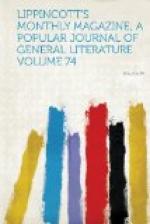Does that look like the conduct of a light and fickle heart? or was it likely that so noble a man as Charles Mountjoy would have died of grief for the disgrace he had brought upon a notoriously bad woman? As to Lord Southampton’s alleged flirtation with Lady Rich, which so excited Elizabeth Vernon’s jealousy, Mr. Massey has not one circumstance in proof of it but the forced interpretation he chooses to put upon certain lines of certain sonnets which he has wrested from their proper places, as well as their proper meaning. After using such sonnets as the 144th to express this jealousy, he quietly confesses at the end of the chapter that it could not have gone very deep, as the intimacy of the two fair cousins (for such was their relationship) continued to be of the closest—that it was to Lady Rich’s house that Elizabeth Vernon retired after her secret marriage to the earl in 1598, and there her baby was born, named Penelope after her cousin and friend! There was only matter enough in it for poetry, Mr. Massey concludes after having upset the whole order of the Sonnets to prove its reality.
Now, as to the story of Lady Rich’s having been the mistress of Herbert, for whom Mr. Massey says that twenty-four of the Sonnets were written. William Herbert, afterward earl of Pembroke, was born in 1580. He came up to London in 1598, being then eighteen years of age, and made the acquaintance of Shakespeare, who was then thirty-four years old. Lady Rich, at that time, according to Mr. Massey’s own statement, was “getting on for forty.” The fact is that she was just thirty-five, having been born, as he tells us, in 1563. According to the obvious meaning of the Sonnets, the lady spoken




